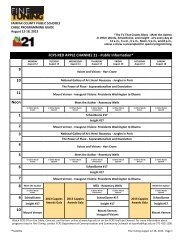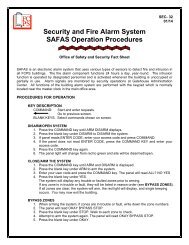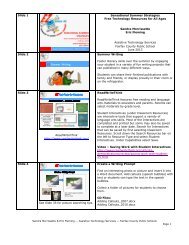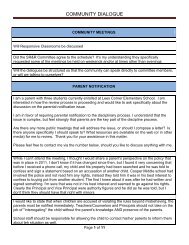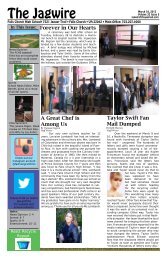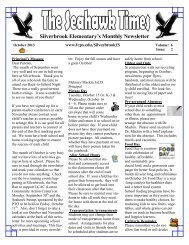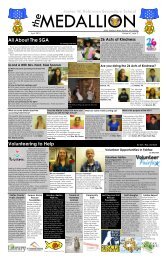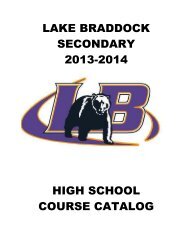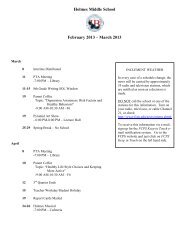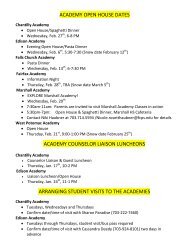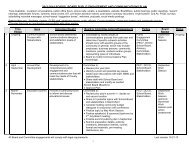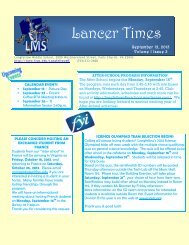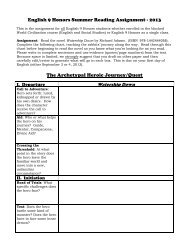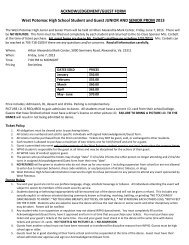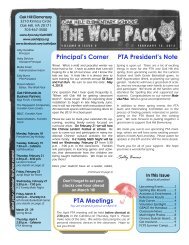FCPS School Improvement Planning Process - Fairfax County ...
FCPS School Improvement Planning Process - Fairfax County ...
FCPS School Improvement Planning Process - Fairfax County ...
You also want an ePaper? Increase the reach of your titles
YUMPU automatically turns print PDFs into web optimized ePapers that Google loves.
<strong>Fairfax</strong> <strong>County</strong> Public <strong>School</strong>s<br />
<strong>School</strong> <strong>Improvement</strong> Plan<br />
2011 – 2012<br />
Kilmer Middle <strong>School</strong><br />
Cluster II<br />
Douglas Tyson, Principal
<strong>FCPS</strong> <strong>School</strong> <strong>Improvement</strong> <strong>Planning</strong> <strong>Process</strong><br />
“Continuous <strong>Improvement</strong>”<br />
May<br />
Study <strong>School</strong><br />
<strong>Improvement</strong> Plan<br />
Objectives Results<br />
(Results and Reflection)<br />
Determine Whether<br />
<strong>School</strong> <strong>Improvement</strong><br />
Objectives Will Be:<br />
Standardized<br />
Modified<br />
Abandoned<br />
STUDY<br />
ACT<br />
DO<br />
Implement <strong>School</strong><br />
<strong>Improvement</strong> Plan<br />
Objectives<br />
(Implement Work<br />
Plan Strategies)<br />
October<br />
Review<br />
Student<br />
Performance<br />
Data<br />
August<br />
(formative and<br />
summative) Determine<br />
Programmatic/<br />
Instructional Strengths<br />
& Weaknesses<br />
PLAN<br />
Develop<br />
Work Plan<br />
Strategies<br />
Develop<br />
Performance<br />
Indicators<br />
Research Best Practices<br />
Develop <strong>School</strong><br />
<strong>Improvement</strong> Plan<br />
Objectives<br />
Department of Accountability<br />
Office of Educational <strong>Planning</strong><br />
Revised January 28, 2008
Name Position<br />
Douglas Tyson Principal<br />
Susan Britton Assistant Principal<br />
Ronald James Assistant Principal<br />
Valerie Hardy Director of Student Services<br />
COMMITTEE MEMBERS<br />
Heather VanAlstyne Assessment Coach/Committee Chair<br />
Brian Herberger <strong>School</strong> Based Technology Specialist<br />
Collin Whitt English Department Chair<br />
Rich Erler Math Department Chair<br />
Christina Miller Science Department Chair<br />
Christopher Custis Social Studies Department Chair<br />
Daniel Hornbecker Counselor<br />
Dora Yarborough-Howard Special Education Department Chair<br />
Susanne Ehsani ESOL Department Chair<br />
Missie Farrace Foreign Language Department Chair<br />
Mary Layher Physical Education Department Chair<br />
Kent Schweitzer Family & Consumer Sciences,<br />
Business, Tech Ed Department Chair<br />
Brett Dodson Fine Arts Department Chair<br />
Margaret Kerfoot PTA President/Parent<br />
1
VISION AND MISSION STATEMENTS AND CORE VALUES/BELIEFS<br />
FAIRFAX COUNTY PUBLIC SCHOOLS—VISION STATEMENT<br />
LOOKING TO THE FUTURE—<strong>FCPS</strong> prepares all students for the world of the future, by giving them a broad spectrum of opportunities to prepare for<br />
education and employment beyond high school. All graduates are productive and responsible members of society, capable of competing in the global<br />
economy, and motivated to pursue learning throughout their lifetimes.<br />
COMMITMENT TO OPPORTUNITY—<strong>FCPS</strong> values its diversity, and acknowledges that all people contribute to the well-being of the community.<br />
<strong>FCPS</strong> provides opportunities for all its students and employees to grow educationally, personally, and professionally.<br />
COMMUNITY SUPPORT—<strong>Fairfax</strong> <strong>County</strong> embraces its schools. Businesses and community members generously volunteer their time and resources<br />
to help students. <strong>School</strong>s are integrated into the fabric of the community, and residents take pride in their schools. The success of <strong>FCPS</strong> draws<br />
businesses to <strong>Fairfax</strong> <strong>County</strong>. Citizens support the financial and capital needs of the school system.<br />
ACHIEVEMENT—<strong>Fairfax</strong> <strong>County</strong> students achieve at high levels across a broad spectrum of pursuits. <strong>FCPS</strong> values a well-rounded education that<br />
goes beyond basics, and encompasses the arts, literacy, technology, and preparation for the world of work. <strong>FCPS</strong> provide a breadth and depth of<br />
opportunities to allow all students to stretch their capabilities.<br />
ACCOUNTABILITY—<strong>FCPS</strong> is accountable for the academic achievement of all students. <strong>FCPS</strong> measures academic progress to ensure that all<br />
students, regardless of race, poverty, language, or disability, will graduate with the knowledge and skills necessary for college and/or employment.<br />
<strong>FCPS</strong> spends money wisely. <strong>FCPS</strong> directs funds to the classroom, and finds ways to improve performance across the spectrum of academic programs<br />
and business processes.<br />
FAIRFAX COUNTY PUBLIC SCHOOLS—MISSION STATEMENT<br />
<strong>Fairfax</strong> <strong>County</strong> Public <strong>School</strong>s, a world-class school system, inspires, enables, and empowers students to meet high academic standards, lead ethical<br />
lives, and demonstrate responsible citizenship.<br />
FAIRFAX COUNTY PUBLIC SCHOOLS—BELIEFS<br />
We Believe in Our Children<br />
Each child is important and entitled to the opportunity to realize his or her fullest potential.<br />
High expectations promote high achievement.<br />
We Believe in Our Teachers<br />
Effective teachers are essential to student success.<br />
Learning occurs best when instruction is tailored to individual needs.<br />
We Believe in Our Public Education System<br />
Adults and children thrive in a vibrant, safe, enriching, and respectful environment.<br />
A well-rounded education enables students to lead fulfilling and culturally rich lives.<br />
An educated citizenry is critical to sustaining our economy and our system of self-governance.<br />
We Believe in Our Community<br />
A dynamic partnership among students, parents, teachers, staff members, and the community is critical to exceptional student achievement.<br />
Our diversity creates resilient, open, and innovative citizens of the global community.<br />
2
SCHOOL—VISION STATEMENT<br />
To provide a safe environment which dares each individual to embrace new challenges in a resourceful and collaborative learning<br />
community.<br />
SCHOOL—MISSION STATEMENT<br />
To empower staff and students through positive opportunities and quality education<br />
SCHOOL—CORE VALUES/BELIEFS<br />
Students prosper in an environment that is safe and challenging.<br />
When working in a collaborative environment, teachers provide meaningful instruction to individual students.<br />
Quality education is a result of the partnership among students, teachers, parents, and the community.<br />
3
SPECIAL PROGRAMS<br />
Student Achievement Goal- Academics<br />
Mathematics Science Technology focus school<br />
Cougars PAWS (time and support for students and program for students with academic deficiencies)<br />
Cougars Read<br />
Collaborative Learning Team focus school<br />
College Partnership Program<br />
Cougars Den (After-<strong>School</strong> Program)<br />
Kilmer Electronic Progress Reporting System<br />
Academic Achievement Council (teacher and staff advisory group to the principal)<br />
Non-fiction writing across the curriculum initiative<br />
Jumpstart Summer Program (thirty rising 7 th graders attended a two-week summer program to help prepare them<br />
academically and socially to adjust to middle school)<br />
Kilmer Middle <strong>School</strong> Academic Intervention Plan<br />
Saturday <strong>School</strong><br />
Learning Seminar (specific academic intervention period by subject)<br />
<strong>Planning</strong> year for AVID program (to be implemented in 2012)<br />
Math Counts<br />
Student Achievement Goal- Essential Life Skills<br />
Cougars ROAR: PBIS (Positive Behavior Interventions and Support)<br />
Power Team<br />
Intramurals/Health Fitness Program<br />
Kilmer Kidz Count (inclusive students with disabilities completing service projects with students without disabilities)<br />
Community Based Instruction (students with disabilities working in the community)<br />
Student Assistant Program (helping students with moderate/severe disabilities)<br />
Inclusion Program (Students with Intellectual Disabilities in GTC core and general elective classes)<br />
Student Council Advisory (student advisory group to the principal)<br />
Odyssey of the Mind (problem based learning)<br />
Junior Achievement Finance Park<br />
4
Student Achievement Goal- Responsibility to the Community<br />
Business Partnership with Noblis<br />
<strong>School</strong> Counselor Assistant (Student aids at Kilmer Center)<br />
National Junior Honor Society service hours<br />
Student Mentoring Program<br />
Multicultural Parent Night (sponsored by Minority Student Achievement)<br />
Civics Service Learning Project<br />
Green Workshops (Environmental Awareness)<br />
Model United Nations<br />
Mock Political Election<br />
5
STUDENT ACHIEVEMENT GOAL—ACADEMICS<br />
STUDENT ACHIEVEMENT GOAL: All students will obtain, understand, analyze, communicate, and apply knowledge and skills to<br />
achieve success in school and life.<br />
Check all that apply to this school improvement plan objective.<br />
X 1.1. Achieve their full academic potential in the core<br />
disciplines of:<br />
X 1.1.1 English language arts<br />
X 1.1.2 Mathematics<br />
X 1.1.3 Science<br />
X 1.1.4 Social studies<br />
1.2 Communicate in at least two languages<br />
6<br />
1.3 Explore, understand, and value the fine and<br />
practical arts.<br />
1.4 Understand the interrelationship and<br />
interdependence of the countries and cultures of the<br />
world.<br />
X 1.5 Effectively use technology to access, communicate,<br />
and apply knowledge and to foster creativity.<br />
SCHOOL IMPROVEMENT PLAN OBJECTIVE: (action-oriented: What we will do to improve programmatic and/or instructional<br />
effectiveness)<br />
A) Continue to close the achievement gap, with a focus on students with disabilities, through the use of the Academic Intervention<br />
Database, analyzing eCart data to drive instructional decisions, and the continued use of established department/CLT<br />
intervention models<br />
B) Increase student academic achievement in all subject areas by ensuring that students develop effective reading and writing<br />
skills through cross-curricular research based instruction<br />
RATIONALE FOR OBJECTIVE: (student performance data; knowledge of programmatic/instructional strengths and weaknesses; bestpractice<br />
research)
Data Sources:<br />
7
Knowledge of Programmatic/Instructional Strengths and Weaknesses:<br />
Since 2008, Kilmer has made gains in closing the achievement gap among the Hispanic and Black subgroups in nearly every content<br />
area. However, as evidenced in the first two graphs, the gap remains apparent in the Students with Disabilities subgroup. For FY2012,<br />
Kilmer will focus on helping all students reach their full academic potential while taking big steps to ensure that students with<br />
disabilities are succeeding.<br />
Strengths:<br />
At Kilmer, teachers teach the appropriate content and curriculum that is aligned with the Virginia Standards of Learning and the<br />
division’s Program of Studies. Teachers use Collaborative Learning Team (CLT) to develop assessments aligned to content in order<br />
to determine what concepts students have mastered and what concepts need to be addressed due to deficiency. Data from the<br />
assessments are shared with the CLT in order to determine what content should be revisited in classes and to guide conversations<br />
about strategies to most effectively reteach the content. Additionally, data from assessments are used to identify individual students<br />
who are struggling with the content. Teachers address intervention needs through programs incorporated during Paws, after school,<br />
and during the school day. Contact with the parents of these individuals is increased to encourage participation in afterschool help. All<br />
teachers email progress reports to parents every two weeks. Reports are mailed to parents without email access.<br />
The Math Department continues to utilize a “bear” list of identified at-risk students. These students are monitored throughout the year<br />
and discussed in CLT regularly. The Algebra CLT uses a common syllabus including a common grading policy. A structured<br />
afterschool support program has been designed to help all learners and reinforce that the entire department is collectively responsible<br />
for the math education of every student. They are committed to developing and using formative assessments and consistently using<br />
PAWS as an intervention / enrichment time. Additional staff support has been provided to Math 8 classes this year. Additionally, the<br />
Math Department is committed to providing students with multiple opportunities for mastery.<br />
Last year, the Science Department continued with monthly presentations in department meetings of various Kagan cooperative<br />
learning strategies. Using the SOL Lab review book as well as eCart data, students were identified for an after-school intervention<br />
program. The review program consisted of an intense review of 7 th grade material conducted by 7 th grade teachers and 8 th grade<br />
material reviewed by 8 th grade teachers. These sessions were held after school every other week. A common 7 th grade final exam was<br />
administered and the results will be compiled and given to 8 th grade teachers. Due to an increase in level 3/4 ESOL students in some<br />
of our science classes, a team taught ESOL Science class will be offered this year.<br />
English teachers were successful in identifying a majority of students’ reading levels by administering the Scholastic Reading<br />
Inventory (SRI). The results of this test allowed teachers to have informed, individualized discussions with students and parents about<br />
choosing appropriate books and supplied an additional piece of information in choosing students for support through Read 180 and<br />
Action Literacy classes. Struggling students were identified using formative assessments such as warm up quizzes, eCart assessments,<br />
and released SOL tests. Students were invited, in small groups, to attend focused remediation sessions during lunch and after school.<br />
14
The English Department collaborated to create student-centered remediation lessons to address the most difficult skills in each unit.<br />
Within the classroom, the lessons created were used at stations and in lessons to focus on areas of weakness.<br />
The Social Studies Department utilizes data from last year’s SOL results to identify areas of improvement and continues to integrate<br />
best practices into teaching. The Department teachers participate in continuing education courses as well as utilize the Social Studies<br />
E-Cart database both for additional lessons and resources. In addition, the Department works on incorporating improved resources<br />
and lessons in the new Program of Studies units such as Globalization and Reconstruction. The Social Studies Department (in their<br />
CLTs) developed assessments aligned to content in order to determine what concepts students have mastered and what concepts need<br />
to be retaught. Data from the assessments are shared with the grade level CLT in order to determine what content should be revisited<br />
in classes and to guide conversations about strategies to most effectively revisit the content. Additionally, data from assessments is<br />
used throughout the year to identify individual students who are struggling with the content. Contact with the parents of these<br />
individuals is increased to encourage participation in afterschool help. Teachers address the needs of these particular students through<br />
a variety of intervention programs incorporated during Paws, after school, and during the school day. The 7 th and 8 th grade CLTs<br />
continued with a remediation program during PAWs through the help of peer tutors earning service hours.<br />
Weaknesses:<br />
The Academic Intervention Database that was implemented last year to track struggling students and confirm parent contacts was not<br />
used by all teachers. For some teachers, finding the database and inputting data was an additional burden. This year, the Assessment<br />
Coach will visit CLTs to review the database with teachers, share ways other teachers have effectively used the database, and provide<br />
reports of database information<br />
The Math department has experienced a significant amount of turnover in the past few years and must spend CLT time getting new<br />
teachers up to speed. Additionally, the department no longer has a resource teacher dedicated to solely assisting math students. The<br />
CLTs are challenged with finding time to write common assessments, review test results for trends, establish remediation plans,<br />
identify natural and appropriate extensions for advanced learners, establish grading norms, and establish a culture of collaboration<br />
because each teacher in the Math Department has at least two preps. Perhaps the greatest challenge for the department this year is that<br />
VGLA is no longer an option for students with disabilities.<br />
Within the English department, the SRI test was used to identify students in need of additional support. However, not all teachers in<br />
the department tested students. Also, the collaboration regarding the SOL remediation sessions was lacking and teachers conducted<br />
the review sessions very differently. Lastly, as evidenced in the graph below, a large portion of students are passing the Writing SOL<br />
test, but the number of students passing the test at the advanced level is low compared to other subject areas and has decreased over<br />
the past two years.<br />
15
The Science department’s biggest challenge was the class sizes of the sections containing students with disabilities and ESOL<br />
students. CLTs struggled to find time for the discussion of successful classroom assignments and activities while focusing on<br />
recreating Horizon tests. Furthermore, administering these tests was difficult because of the high number of students requiring special<br />
testing accommodation and ESOL students requiring read aloud tests.<br />
The Social Studies department needs to continue to integrate best practices into our teaching and will attempt to meet this goal by<br />
increasing the number of teacher observations of classrooms this year. Additionally, CLT will be used to create engaging lessons for<br />
topics that are identified as challenging based on last year’s SOL results.<br />
Best Practice Research:<br />
In the book, Data Driven Instruction, Bambrick-Santoyo emphasizes the importance of using data to make instructional decisions and<br />
to determine the answer to an important instructional question: are students learning? He highlights four key principles in using data<br />
to drive instruction:<br />
Assessment: Create rigorous interim assessments that provide meaningful data.<br />
Analysis: Examine the results of assessments to identify the causes of both strengths and shortcomings.<br />
Action: Teach effectively what students need to learn<br />
16
Culture: Create an environment in which data-driven instruction can survive and thrive.<br />
At Kilmer, the framework has been established to address each of the four key principles. Teachers in the core subject areas give<br />
quarterly eCart assessments. The results are then analyzed in CLT meetings, and teachers collaborate to determine what needs to be<br />
revisited and what was taught effectively. Currently, Kilmer has very strong CLTs, and by frequently looking at data at CLT<br />
meetings, we will continue to create a culture where data is considered when making instructional decisions.<br />
Furthermore, while Kilmer focuses on closing the achievement gap for students with disabilities, it is essential that general education<br />
teachers are equipped with the knowledge necessary to meet the needs of these students. According to Douglass and Lynn Fuchs of<br />
Vanderbilt University, 40% of students with learning disabilities have general education teachers who receive no information about<br />
their instructional needs, and only 11% of students with LD receive modifications to the general education curriculum. As outlined in<br />
Kilmer’s Action Plan, the special education department chair, Dora Yarborough-Howard, will ensure that all teachers are equipped to<br />
effectively meet the educational needs of students with disabilities through special education professional development opportunities<br />
provided to general education teachers.<br />
17
STUDENT ACHIEVEMENT GOAL—ACADEMICS<br />
Sub-Goal<br />
Performance Indicators<br />
Number<br />
(Specific Measurable Attainable Results-Oriented and Time-Bound)<br />
1.1.1 The SOL achievement gap for Hispanic students in Writing will decrease to become lower than 7.3 percentage points<br />
as compared to White student achievement.<br />
1.1.1 16% of all students will pass advanced on the Writing SOL.<br />
1.1.2 The SOL achievement for Special Education students on the Algebra EOC will increase to 100%.<br />
1.1.2 The SOL achievement for Special Education and LEP students on the Plain English Math 7 SOL will increase to at<br />
least 67%.<br />
1.1.2 The SOL achievement for Special Education and LEP students on the Plain English Math 8 SOL will increase to at<br />
least 67%.<br />
1.1.1, , 1.1.3,<br />
1.1.4<br />
1.1.1, 1.1.2,<br />
1.1.3, 1.1.4<br />
SOL pass advance rates will increase by 5% in History, Civics, Reading 7, and Reading 8, Science.<br />
The number of students retained will be zero.<br />
18
STUDENT ACHIEVEMENT GOAL—ACADEMICS<br />
WORK PLAN<br />
SCHOOL IMPROVEMENT PLAN OBJECTIVE:<br />
A) Continue to close the achievement gap, with a focus on students with disabilities, through the use of the Academic Intervention Database,<br />
analyzing eCart data to drive instructional decisions, and the continued use of established department/CLT intervention models<br />
B) Increase student academic achievement in all subject areas by ensuring that students develop effective reading and writing skills through<br />
cross-curricular research based instruction<br />
Strategies Person(s) Responsible Materials<br />
Needed and<br />
Costs<br />
Time Line In-<strong>Process</strong> Measures<br />
What we will do to achieve the Person(s) who will monitor What materials will Check the projected How we will monitor progress.<br />
objective.<br />
the strategy.<br />
be used to quarter for implementing<br />
(Include professional development and<br />
implement the the strategy this school<br />
parent involvement)<br />
strategy? What are<br />
year.<br />
the costs? 1 st<br />
2<br />
Qtr.<br />
nd<br />
3<br />
Qtr.<br />
rd<br />
4<br />
Qtr.<br />
th<br />
Qtr.<br />
Academic Intervention Database Teachers must input data Microsoft Access X X X X Academic Intervention Database<br />
Teachers, professional school<br />
Database<br />
counselors, and<br />
Professional <strong>School</strong><br />
Monthly reports check sheet<br />
administrators will track Counselors will monitor<br />
interventions for students on database for students<br />
the Academic Intervention with multiple<br />
Database.<br />
interventions<br />
See attached sample page,<br />
page 24.<br />
Assessment Coach<br />
Assessment Coach will<br />
provide monthly reports for<br />
Administration and<br />
Professional <strong>School</strong><br />
Counselors.<br />
Heather VanAlstyne will<br />
provide monthly reports<br />
Students At-Risk Database<br />
Assessment Coach Excel and SASI X X X X Teacher survey to gauge<br />
Using SASI and EDSL, an<br />
excel database will be used to<br />
Heather VanAlstyne<br />
usefulness<br />
house important information Administrator Ron<br />
for at-risk students.<br />
James<br />
19
SCHOOL IMPROVEMENT PLAN OBJECTIVE:<br />
A) Continue to close the achievement gap, with a focus on students with disabilities, through the use of the Academic Intervention Database,<br />
analyzing eCart data to drive instructional decisions, and the continued use of established department/CLT intervention models<br />
B) Increase student academic achievement in all subject areas by ensuring that students develop effective reading and writing skills through<br />
cross-curricular research based instruction<br />
Strategies Person(s) Responsible Materials<br />
Needed and<br />
Costs<br />
Time Line In-<strong>Process</strong> Measures<br />
What we will do to achieve the Person(s) who will monitor What materials will Check the projected How we will monitor progress.<br />
objective.<br />
the strategy.<br />
be used to quarter for implementing<br />
(Include professional development and<br />
implement the the strategy this school<br />
parent involvement)<br />
strategy? What are<br />
year.<br />
the costs? 1 st<br />
2<br />
Qtr.<br />
nd<br />
3<br />
Qtr.<br />
rd<br />
4<br />
Qtr.<br />
th<br />
Qtr.<br />
Saturday Intervention Program Teachers<br />
$20,000 X X X Data collection of<br />
At-risk students actively<br />
identified/participating students<br />
engaged in the Saturday Professional <strong>School</strong><br />
<strong>School</strong> Program will get the Counselor Brian<br />
additional support needed to<br />
earn a passing grade for the<br />
Sirdofsky<br />
year.<br />
Administrative Team<br />
Professional development for AAP Administrative Team <strong>County</strong> offered X X X X My PLT registration<br />
teachers<br />
PLT classes for<br />
Curriculum extensions above Teachers<br />
science, social<br />
the POS, particularly in<br />
studies, and<br />
writing<br />
English<br />
To promote vertical articulation and Teachers<br />
Two sub days per X X X Survey results<br />
align teaching and learning, teachers<br />
teacher are<br />
will have the opportunity to observe Administrative Team available. If<br />
Teacher reflections/feedback<br />
colleagues at feeder elementary<br />
every teacher<br />
schools and high schools.<br />
takes advantage<br />
of the opportunity<br />
this will cost<br />
$15,000<br />
20
SCHOOL IMPROVEMENT PLAN OBJECTIVE:<br />
A) Continue to close the achievement gap, with a focus on students with disabilities, through the use of the Academic Intervention Database,<br />
analyzing eCart data to drive instructional decisions, and the continued use of established department/CLT intervention models<br />
B) Increase student academic achievement in all subject areas by ensuring that students develop effective reading and writing skills through<br />
cross-curricular research based instruction<br />
Strategies Person(s) Responsible Materials<br />
Needed and<br />
Costs<br />
Time Line In-<strong>Process</strong> Measures<br />
What we will do to achieve the Person(s) who will monitor What materials will Check the projected How we will monitor progress.<br />
objective.<br />
the strategy.<br />
be used to quarter for implementing<br />
(Include professional development and<br />
implement the the strategy this school<br />
parent involvement)<br />
strategy? What are<br />
year.<br />
the costs? 1 st<br />
2<br />
Qtr.<br />
nd<br />
3<br />
Qtr.<br />
rd<br />
4<br />
Qtr.<br />
th<br />
Qtr.<br />
KMS will maintain an ESOL<br />
STUDENT blackboard site available<br />
for students and their families that<br />
contain pertinent information on a<br />
school and county level.<br />
ESOL Department Blackboard X X X X Number of visitors on the site<br />
Kilmer’s Math and English Resource Resource Teacher: Remediation X X X X Benchmark assessments, eCart<br />
teacher will work in small groups Evelyn Reynolds resources<br />
test results<br />
with students who are not meeting<br />
(workbooks,<br />
their academic potential. This Assessment Coach: lessons, websites)<br />
includes AAP students.<br />
Heather VanAlstyne<br />
Cost $1000<br />
Teachers will develop an after-school Teachers Blackboard X X X X Teacher Blackboard Site and<br />
schedule that provides support to<br />
students. This information must be<br />
posted on Blackboard.<br />
After school attendance<br />
Teachers will give quarterly<br />
formative assessment. Results will<br />
Departments<br />
Computers X X X X Student test reports/log-ins<br />
be used to drive instruction in every<br />
department.<br />
Brian Herberger (SBTS)<br />
Heather VanAlstyne<br />
(Assessment Coach)<br />
eCART training<br />
Data analysis at CLT meetings<br />
21
SCHOOL IMPROVEMENT PLAN OBJECTIVE:<br />
A) Continue to close the achievement gap, with a focus on students with disabilities, through the use of the Academic Intervention Database,<br />
analyzing eCart data to drive instructional decisions, and the continued use of established department/CLT intervention models<br />
B) Increase student academic achievement in all subject areas by ensuring that students develop effective reading and writing skills through<br />
cross-curricular research based instruction<br />
Strategies Person(s) Responsible Materials<br />
Needed and<br />
Costs<br />
Time Line In-<strong>Process</strong> Measures<br />
What we will do to achieve the Person(s) who will monitor What materials will Check the projected How we will monitor progress.<br />
objective.<br />
the strategy.<br />
be used to quarter for implementing<br />
(Include professional development and<br />
implement the the strategy this school<br />
parent involvement)<br />
strategy? What are<br />
year.<br />
the costs? 1 st<br />
2<br />
Qtr.<br />
nd<br />
3<br />
Qtr.<br />
rd<br />
4<br />
Qtr.<br />
th<br />
Qtr.<br />
Administer the SRI test to identify Reading Specialist SRI Test<br />
X X X X Compare pre and post SRI scores<br />
students in need of remediation and Peggy Ford<br />
Computer Lab<br />
to determine if remediation<br />
to track reading progress.<br />
English teachers<br />
strategies are successful<br />
Students identified as a Student with Dora Yarbrough-Howard Special Ed X X X X Academic Intervention<br />
a Disability will have a profile with (Special Ed Department Student Data<br />
past test scores, best practices Chair)<br />
Profile<br />
Number of teachers accessing<br />
teachers can use with that student and<br />
student profiles<br />
progress will be monitored closely. Teachers<br />
Professional Development for Dora Yarbrough-Howard Courses offered X X Teacher feedback<br />
teachers teaching students with (Special Ed Department through my PLT<br />
disabilities.<br />
Chair)<br />
Early Release<br />
PLT registration<br />
Teachers<br />
Day<br />
Professional development needs of<br />
the staff will be compiled in order to<br />
address the following year.<br />
Assessment Coach<br />
Cost $500<br />
Survey Survey Monkey<br />
22
SCHOOL IMPROVEMENT PLAN OBJECTIVE:<br />
A) Continue to close the achievement gap, with a focus on students with disabilities, through the use of the Academic Intervention Database,<br />
analyzing eCart data to drive instructional decisions, and the continued use of established department/CLT intervention models<br />
B) Increase student academic achievement in all subject areas by ensuring that students develop effective reading and writing skills through<br />
cross-curricular research based instruction<br />
Strategies Person(s) Responsible Materials<br />
Needed and<br />
Costs<br />
Time Line In-<strong>Process</strong> Measures<br />
What we will do to achieve the Person(s) who will monitor What materials will Check the projected How we will monitor progress.<br />
objective.<br />
the strategy.<br />
be used to quarter for implementing<br />
(Include professional development and<br />
implement the the strategy this school<br />
parent involvement)<br />
strategy? What are<br />
year.<br />
the costs? 1 st<br />
2<br />
Qtr.<br />
nd<br />
3<br />
Qtr.<br />
rd<br />
4<br />
Qtr.<br />
th<br />
Qtr.<br />
Students will complete one piece of English Department None X X Student writing<br />
non-fiction writing in every content<br />
area each semester.<br />
chair Collin Whitt<br />
23
STUDENT ACHIEVEMENT GOAL—ESSENTIAL LIFE SKILLS<br />
STUDENT ACHIEVEMENT GOAL: All students will demonstrate the aptitude, attitude, and skills to lead responsible, fulfilling,<br />
and respectful lives.<br />
Check all that apply to this school improvement plan objective.<br />
X 2.1 Demonstrate honesty, responsibility, and leadership.<br />
2.2 Work effectively within a group dynamic.<br />
X 2.3 Develop the resilience and self-confidence required<br />
to deal effectively with life’s challenges.<br />
X 2.4 Possess the skills to manage and resolve conflict.<br />
25<br />
2.5 Be inspired to learn throughout life.<br />
2.6 Courageously identify and pursue their personal<br />
goals.<br />
X 2.7 Develop practical life skills.<br />
X 2.8 Make healthy and safe life choices.<br />
SCHOOL IMPROVEMENT PLAN OBJECTIVE: (action-oriented: What we will do to improve programmatic and/or instructional<br />
effectiveness)<br />
By using a school wide Positive Behavior Interventions and Support (PBIS), we will create a more encouraging, safe, and orderly<br />
environment for the Kilmer school community.<br />
RATIONALE FOR OBJECTIVE: (student performance data; knowledge of programmatic/instructional strengths and weaknesses; bestpractice<br />
research)<br />
Data Sources:<br />
FY2011 Discipline Data<br />
Behavior Sept. Oct. Nov. Dec. Jan. Feb. Mar. Apr. May June Total<br />
Defiance 2 7 7 9 8 15 9 5 2 4 68<br />
Disrespect 5 10 2 2 3 6 8 6 7 3 52<br />
Class Disruptions 3 5 6 0 1 5 14 4 4 1 43<br />
Inappropriate<br />
Language/Gestures<br />
1 5 0 1 0 2 2 2 2 2 17
Knowledge of Programmatic/Instructional Strengths and Weaknesses:<br />
Last year the program experienced a great deal of growth. The size of the committee increased, monthly presentations were done at<br />
faculty meetings, and classroom lessons were distributed to teachers. With the growth of the program, we saw a decline in class<br />
disruptions and inappropriate language throughout the building. However, several challenges exist that need to be addressed this year.<br />
After increasing the emphasis of PBIS within the school in FY2011, Kilmer saw an increase in defiant and disrespectful behavior.<br />
Lessons addressing these negative behaviors will be emphasized in PAWS. Additionally, in FY20011, the effectiveness of the PBIS<br />
program was based exclusively on discipline data. This data does not capture the effectiveness of the program for a majority of<br />
Kilmer students; therefore, the PBIS goals will be measured using several indicators.<br />
Best Practice Research:<br />
Through <strong>School</strong>-wide Positive Behavior Interventions and Support, students assume ownership over their behavioral choices when<br />
they take responsibility for their actions, choose their attitudes, and respect themselves and others (George Sugai, 2007). “Pupil<br />
achievements and behavior can be influenced (for the better or worse) by overall characteristics of school…this means focus on<br />
features promoting good functioning at classroom, departmental, or whole school level” (Rutte and Maughan, 2002). Numerous<br />
studies have found that a positive school climate can yield positive educational and psychological outcomes for students and school<br />
personnel; similarly, a negative climate can prevent optimal learning and development. <strong>School</strong>s with a positive and welcoming school<br />
climate increase the likelihood that students succeed academically while protecting them from engaging in high risk behaviors like<br />
substance abuse and violence (The Center for Study and Prevention of Violence, 2000).<br />
Positive Behavior Interventions and Support (PBIS) is designed to change behavior by rewarding appropriate behavior wherever it<br />
may occur in the school. By doing this, we improve the teaching and learning environment at Kilmer Middle <strong>School</strong>. Essential life<br />
behaviors are embedded at the core of the Positive Behavior Interventions and Support program. Educating students about expected<br />
and appropriate behaviors in the school environment correlates to improved student behaviors outside of the school environment. The<br />
Positive Behavior Interventions and Support program is a method of changing student behaviors, not a discipline program. Program<br />
supports, such as the teaching matrix, monthly lessons, and the recognition system, provide teachers with a practical set of school wide<br />
behavior expectations which can be utilized to maintain a safe and productive learning environment.<br />
26
Sub-Goal<br />
Number<br />
2.1, 2.3, 2.4,<br />
2.8<br />
2.1, 2.3, 2.4<br />
2.7, 2.4<br />
2.1, 2.3, 2.7,<br />
2.8<br />
STUDENT ACHIEVEMENT GOAL—ESSENTIAL LIFE SKILLS<br />
Performance Indicators<br />
(Specific Measurable Attainable Results-Oriented and Time-Bound)<br />
95% of students will report feeling safe at Kilmer.<br />
95% of students will report feeling respected at Kilmer.<br />
Tardiness will decrease by 10% from first semester to second semester.<br />
The number of discipline referrals will decrease by 10 compared with FY2011 data.<br />
27
STUDENT ACHIEVEMENT GOAL—ESSENTIAL LIFE SKILLS<br />
WORK PLAN<br />
SCHOOL IMPROVEMENT PLAN OBJECTIVE:<br />
By using a school wide Positive Behavior Interventions and Support (PBIS), we will create a more encouraging, safe, and orderly environment for<br />
the Kilmer school community<br />
Strategies Person(s)<br />
What we will do to achieve the<br />
objective.<br />
(Include professional development<br />
and parent involvement)<br />
KMS staff will be informed of<br />
school-wide data related to student<br />
behavior.<br />
KMS staff will teach ROAR (respect,<br />
ownership, attitude, and<br />
responsibility) to all students with<br />
monthly PAWS lessons. Lessons<br />
addressing defiance and disrespect<br />
will be added.<br />
Staff will recognize acknowledge,<br />
and reward students for good<br />
behaviors. All staff will distribute<br />
ROAR cards to students to recognize<br />
appropriate behaviors<br />
Responsible<br />
Person(s) who<br />
will monitor the<br />
strategy.<br />
Administration<br />
Assessment<br />
Coach Heather<br />
VanAlstyne<br />
PBIS Committee<br />
member Margaret<br />
Santa<br />
Administration<br />
Teachers<br />
PBS Committee<br />
Kilmer Staff<br />
Materials Needed and<br />
Costs<br />
What materials will be<br />
used to implement the<br />
strategy? What are the<br />
costs?<br />
SASI data and student<br />
referrals/reports<br />
Posters<br />
ROAR<br />
lessons/presentations<br />
ROAR cards<br />
$1900<br />
28<br />
Time Line In-<strong>Process</strong> Measures<br />
Check the projected<br />
quarter for implementing<br />
the strategy this school<br />
1 st<br />
Qtr.<br />
2 nd<br />
year.<br />
3 rd<br />
4 th<br />
How we will monitor progress.<br />
Qtr. Qtr. Qtr.<br />
X X X Updates provided at monthly<br />
faculty meetings<br />
X X X X Informal Observations<br />
Teacher lesson check sheet<br />
X X X X Monthly announcements
SCHOOL IMPROVEMENT PLAN OBJECTIVE:<br />
By using a school wide Positive Behavior Interventions and Support (PBIS), we will create a more encouraging, safe, and orderly environment for<br />
the Kilmer school community<br />
Strategies Person(s)<br />
What we will do to achieve the<br />
objective.<br />
(Include professional development<br />
and parent involvement)<br />
Teachers will provide parents with<br />
explanation of the PBIS program to<br />
increase parent involvement via PTA<br />
newsletters<br />
Students will participate in school<br />
climate surveys<br />
Responsible<br />
Person(s) who<br />
will monitor the<br />
strategy.<br />
PBIS Committee<br />
Chair Margaret<br />
Santa<br />
PBIS Committee<br />
Chair Margaret<br />
Santa<br />
Librarian<br />
Gretchen Hazlin<br />
Materials Needed and<br />
Costs<br />
What materials will be<br />
used to implement the<br />
strategy? What are the<br />
costs?<br />
29<br />
Time Line In-<strong>Process</strong> Measures<br />
Check the projected<br />
quarter for implementing<br />
the strategy this school<br />
year.<br />
1 st<br />
2 nd<br />
Qtr. Qtr. Qtr. Qtr.<br />
PTA Newsletters X X X X Parent feedback<br />
Survey Monkey<br />
Blackboard<br />
3 rd<br />
4 th<br />
How we will monitor progress.<br />
Dialogue at PTA meetings<br />
X X Survey results
SCHOOL IMPROVEMENT PLAN OBJECTIVE:<br />
By using a school wide Positive Behavior Interventions and Support (PBIS), we will create a more encouraging, safe, and orderly environment for<br />
the Kilmer school community<br />
Strategies Person(s)<br />
What we will do to achieve the<br />
objective.<br />
(Include professional development<br />
and parent involvement)<br />
In order to maintain consistent<br />
discipline, the referral process will be<br />
reviewed for new faculty in detail.<br />
1st Infraction: Conference<br />
with student, notify parent,<br />
counselor, and Dean of<br />
Students<br />
2 nd Infraction: Notify parent,<br />
counselor, and Dean of<br />
Students. Dean of Students<br />
will conference with student<br />
and written documentation<br />
will be kept at administrative<br />
level.<br />
3 rd Infraction and any<br />
subsequent infraction: Notify<br />
parent, counselor, Dean of<br />
Students, and administrator.<br />
Administrative action will be<br />
taken.<br />
Responsible<br />
Person(s) who<br />
will monitor the<br />
strategy.<br />
Administration<br />
Dean of Students<br />
PBS Committee<br />
Materials Needed and<br />
Costs<br />
What materials will be<br />
used to implement the<br />
strategy? What are the<br />
costs?<br />
Handouts for teachers<br />
Example discipline<br />
referral forms<br />
30<br />
Time Line In-<strong>Process</strong> Measures<br />
Check the projected<br />
quarter for implementing<br />
the strategy this school<br />
year.<br />
1 st<br />
2 nd<br />
3 rd<br />
4 th<br />
How we will monitor progress.<br />
Qtr. Qtr. Qtr. Qtr.<br />
X X X X Feedback from teachers regarding<br />
discipline process
STUDENT ACHIEVEMENT GOAL—RESPONSIBILITY TO THE COMMUNITY<br />
STUDENT ACHIEVEMENT GOAL: All students will understand and model the important attributes that people must have to<br />
contribute to an effective and productive community and the common good of all.<br />
Check all that apply to this school improvement plan objective.<br />
X 3.1 Know and practice the duties, responsibilities, and rights of citizenship in a democratic society.<br />
X 3.2 Be respectful and contributing participants in their school, community, country, and world.<br />
3.3 Understand the purpose, role, and means of interaction with the different levels of government.<br />
X 3.4 Exercise good stewardship of the environment.<br />
SCHOOL IMPROVEMENT PLAN OBJECTIVE: (action-oriented: What we will do to improve programmatic and/or instructional<br />
effectiveness)<br />
Faculty and staff will facilitate service learning opportunities in the school and in the community through curriculum and after-school<br />
activities.<br />
RATIONALE FOR OBJECTIVE: (student performance data; knowledge of programmatic/instructional strengths and weaknesses; bestpractice<br />
research)<br />
Data Sources:<br />
SERVICE LEARNING FY2011:<br />
Fundraisers:<br />
Pennies for Patient---Leukemia Society<br />
Japan Earthquake relief—student initiated and led fundraiser<br />
Cougars’ Den:<br />
Cougars Den Students worked to support recycling program each Thursday evening<br />
31
Loose the Training Wheels—19 students volunteering to help students with disabilities learn how to ride two-wheeled bicycles<br />
for 2.5 hours a day for 5 school days after school.<br />
Student volunteers for school clean up hours with custodians after school<br />
Autism Awareness week- students created poster and flyers to educate community<br />
SCA<br />
Organized an Environmental Awareness Day- Students created posters and organized a day for all students to wear green<br />
in support of “being green”<br />
Food for Others—3 canned food drives, donated over 400 pounds of food<br />
SCA meetings—students get community service hours for attending meetings to help plan events for the school<br />
Environmental<br />
Watershed clean-up<br />
Bottle and can recycling program<br />
Green Club<br />
o Posted flyers with information about ways to “be more green”<br />
o Promoted and attended the Kilmer spring clean-up<br />
Knowledge of Programmatic/Instructional Strengths and Weaknesses:<br />
Service learning is part of the Civics curriculum and students are required to turn in a log of 5 hours per quarter. As a school, the<br />
challenge is in motivating all of our students to complete the hours requirement. In order to address this challenge, service<br />
opportunities are posted on Blackboard, and the After-<strong>School</strong> Program Specialist has been tasked with offering community service<br />
opportunities to students. Additionally, a challenge is documenting the success of the student service requirement. Last year our data<br />
was incomplete. This year, Civics teachers will submit their service hour requirement to Assessment Coach Heather VanAlstyne, and<br />
she will compile the school-wide service hour data quarterly.<br />
Paper recycling has been organized at Kilmer for at least the past 5 years. The Starcatcher team picks up recycling bins once a week in<br />
all classrooms. There are paper recycling bins in every classroom, two plastic bottle receptacles in the cafeteria, and large green allpurpose<br />
recycling bins at the top of major hallways.<br />
Best Practice Research:<br />
Elson Nash, associate director for program management at Learn and Serve America, calls service learning “the glue that makes<br />
things stick," noting that when students feel engaged and empowered, they learn more effectively and connect with real-world issues.<br />
Studies by Shelley Billig, vice president of RMC Research Corporation, links higher state test scores with service learning<br />
participation. Students in high-quality service learning classrooms also were found to have higher average daily attendance and less<br />
tardiness than students from comparison classrooms (Billig, 2005). Service learning is an important piece in developing productive,<br />
caring citizens and will continue to be a priority at Kilmer.<br />
32
STUDENT ACHIEVEMENT GOAL—RESPONSIBILITY TO THE COMMUNITY<br />
Sub-Goal<br />
Number<br />
3.1, 3.2, and<br />
3.4<br />
3.1, 3.2, and<br />
3.4<br />
Performance Indicators<br />
(Specific Measurable Attainable Results-Oriented and Time-Bound Goals)<br />
The percentage of students completing all required service hours will increase to at least 95% each quarter.<br />
100% of Cougars Den participants will participate in one service learning opportunity offered through Cougars Den.<br />
33
SCHOOL IMPROVEMENT PLAN OBJECTIVE:<br />
STUDENT ACHIEVEMENT GOAL—RESPONSIBIITY TO THE COMMUNITY<br />
WORK PLAN<br />
Faculty and staff will facilitate service learning opportunities in the school and in the community through curriculum and after-school activities.<br />
Strategies Person(s)<br />
Responsible<br />
What we will do to achieve the Person(s) who will<br />
objective.<br />
monitor the<br />
(Include professional development and<br />
parent involvement)<br />
strategy.<br />
A list of local organizations offering<br />
service opportunities will be posted<br />
on Blackboard. This posting will<br />
also be announced on the Kilmer<br />
website for parents.<br />
Staff and faculty will recognize<br />
students with exemplary service<br />
hours at the end of the year.<br />
Civics CLT<br />
leader Jeremiah<br />
Feather<br />
Materials Needed and<br />
Costs<br />
What materials will be<br />
used to implement the<br />
strategy? What are the<br />
costs?<br />
Blackboard<br />
Community Resources<br />
<strong>School</strong> website<br />
Librarian<br />
Gretchen Hazlin<br />
8 th grade teachers Data collected from<br />
Service Learning forms<br />
Award certificates<br />
34<br />
Time Line In-<strong>Process</strong> Measures<br />
Check the projected quarter<br />
for implementing the<br />
strategy this school year.<br />
1 st<br />
2 nd<br />
3 rd<br />
4 th<br />
How we will monitor progress.<br />
Qtr. Qtr. Qtr. Qtr.<br />
X X X X Student and parent feedback
SCHOOL IMPROVEMENT PLAN OBJECTIVE:<br />
Faculty and staff will facilitate service learning opportunities in the school and in the community through curriculum and after-school activities.<br />
Strategies Person(s)<br />
Responsible<br />
What we will do to achieve the Person(s) who will<br />
objective.<br />
monitor the<br />
(Include professional development and<br />
parent involvement)<br />
strategy.<br />
Civics teachers will track student<br />
hours of community service hours<br />
quarterly. The completion of the<br />
mandatory 5 hours per quarter will be<br />
recorded by the Civics teachers.<br />
Student who do not complete hours<br />
for the quarter will be placed on a<br />
“tracking list.” Parents will be<br />
contacted by the Civics Department<br />
and an adult in the building will be<br />
assigned to each of these identified<br />
students to assist and encourage them<br />
in developing a personal plan for<br />
fulfilling the requirement in the<br />
upcoming quarters.<br />
Civics teachers instruct all 8 th grade<br />
students to participate in a common<br />
reflection activity pertaining to their<br />
service learning requirement of 20<br />
hours.<br />
Materials Needed and<br />
Costs<br />
What materials will be<br />
used to implement the<br />
strategy? What are the<br />
costs?<br />
35<br />
Time Line In-<strong>Process</strong> Measures<br />
Check the projected quarter<br />
for implementing the<br />
strategy this school year.<br />
1 st<br />
Qtr.<br />
2 nd<br />
Qtr.<br />
3 rd<br />
Qtr.<br />
4 th<br />
Qtr.<br />
How we will monitor progress.<br />
Civics teachers Service Learning form X X X X Civics teachers’<br />
records/spreadsheets<br />
Civics CLT<br />
leader Jeremiah<br />
Feather<br />
None X Teacher observations
SCHOOL IMPROVEMENT PLAN OBJECTIVE:<br />
Faculty and staff will facilitate service learning opportunities in the school and in the community through curriculum and after-school activities.<br />
Strategies Person(s)<br />
Responsible<br />
What we will do to achieve the Person(s) who will<br />
objective.<br />
monitor the<br />
(Include professional development and<br />
parent involvement)<br />
strategy.<br />
Staff will advertise the Cougars Den<br />
program to both students and parents<br />
and by offering service learning<br />
opportunities that appeal to students.<br />
Specific opportunities to complete<br />
service learning will be provided for<br />
students identified for Saturday<br />
<strong>School</strong>.<br />
After-<strong>School</strong><br />
Specialist<br />
Kimberly<br />
Kardelis<br />
Professional<br />
<strong>School</strong><br />
Counselors<br />
Materials Needed and<br />
Costs<br />
What materials will be<br />
used to implement the<br />
strategy? What are the<br />
costs?<br />
Grant money, staff,<br />
forms, flyers, building<br />
use<br />
Translated versions of<br />
flyers and applications<br />
available<br />
Existing Resources<br />
36<br />
Time Line In-<strong>Process</strong> Measures<br />
Check the projected quarter<br />
for implementing the<br />
strategy this school year.<br />
1 st<br />
2 nd<br />
3 rd<br />
4 th<br />
How we will monitor progress.<br />
Qtr. Qtr. Qtr. Qtr.<br />
X X X X Attendance, surveys for<br />
participants.<br />
Local organizations X X X Civics teachers’<br />
records/spreadsheets cross<br />
checked with the list of Saturday<br />
<strong>School</strong> students



